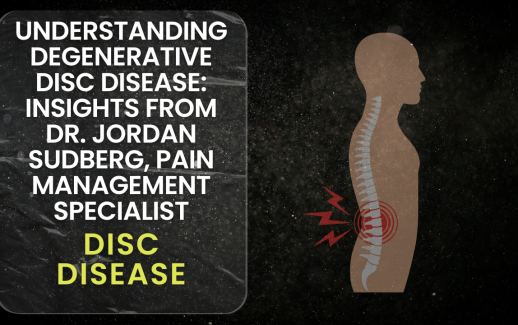When Backs Break Down: Dr. Jordan Sudberg Explains What Really Happens When You ‘Throw Out’ Your Back
It’s a phrase nearly everyone has heard—or said: “I threw out my back.” It might happen while lifting something heavy, bending the wrong way, or even sneezing. One moment you feel fine, and the next, you’re seized by pain, unable to move easily.
But what does it actually mean to “throw your back out”? According to pain management specialist Dr. Jordan Sudberg, this common phrase describes a very real—and often preventable—event involving the muscles, ligaments, or joints of the spine.
“In most cases, when someone says they’ve thrown out their back, they’re experiencing an acute musculoskeletal injury,” Dr. Sudberg explains. “It can involve a muscle strain, ligament sprain, or even a shift in spinal alignment that irritates nearby nerves.”
In this post, Dr. Sudberg walks us through what really happens during one of these painful episodes, how to respond, and—most importantly—how to prevent it from happening again.
What Does It Mean to “Throw Out” Your Back?
The term is informal, but the pain is very real. Most often, “throwing out your back” involves:
- Muscle strain – Overstretching or tearing a muscle, often in the lower back.
- Ligament sprain – Damage to the tough bands that hold bones together.
- Facet joint irritation – Misalignment or inflammation in the small joints between vertebrae.
- Disc issues – In more severe cases, a slipped or herniated disc may press on nerves.
“The lower back is the most common site because it carries the most weight and is involved in nearly every movement,” says Dr. Sudberg.
What Causes It?
While heavy lifting is a common culprit, Dr. Sudberg notes that many cases result from repetitive stress or poor biomechanics—meaning it can happen from seemingly minor movements if your back is already strained.
Common causes include:
- Improper lifting technique
- Sudden twisting or awkward movements
- Weak core muscles
- Sedentary lifestyle
- Poor posture
- Carrying excess weight
- Degenerative disc disease or arthritis
“Sometimes it doesn’t take a dramatic injury,” Sudberg explains. “Bending over to tie your shoe might be the last straw if your back is already under stress.”
Symptoms: What It Feels Like
When someone throws out their back, symptoms typically appear suddenly and can range from mild discomfort to debilitating pain.
Typical symptoms include:
- Sharp, stabbing, or dull lower back pain
- Muscle spasms or tightness
- Pain that worsens with movement or standing
- Limited range of motion
- Difficulty standing upright
- In some cases, pain radiating to the hips or legs
“Muscle spasms are the body’s way of protecting an injured area, but they can be extremely painful,” Dr. Sudberg adds.
What to Do Immediately After
If you think you’ve thrown out your back, Dr. Sudberg recommends the following steps:
- Stop what you’re doing – Avoid further movement to prevent additional injury.
- Apply ice – Use an ice pack for 15–20 minutes at a time for the first 48 hours to reduce inflammation.
- Try gentle movement – After the initial pain subsides, light stretching or walking can help prevent stiffness.
- Over-the-counter pain relief – NSAIDs like ibuprofen can reduce inflammation, but always follow dosing guidelines.
“Don’t stay in bed for too long,” Sudberg warns. “Prolonged rest can actually slow recovery. Light, gentle movement helps promote healing.”
When to Seek Medical Attention
Most cases resolve within a few days to a couple of weeks. However, Dr. Sudberg advises seeing a medical professional if you experience:
- Pain lasting longer than two weeks
- Numbness or tingling in the legs
- Muscle weakness
- Loss of bladder or bowel control (a medical emergency)
“If your symptoms involve nerve compression, prompt treatment is essential to avoid long-term damage,” he says.
Treatment Options from Dr. Jordan Sudberg
As a pain management specialist, Dr. Sudberg offers both conservative and advanced treatment options:
- Physical therapy – To strengthen supporting muscles and restore flexibility.
- Manual therapy – Including massage, spinal adjustments, or myofascial release.
- Interventional procedures – Like trigger point injections or epidurals for more persistent cases.
- Lifestyle coaching – Ergonomic corrections, posture training, and movement re-education.
“Our goal isn’t just to treat the current pain,” Sudberg explains. “It’s to correct the underlying issue and prevent it from happening again.”
Prevention: Protecting Your Back for the Long Haul
To avoid throwing your back out again, Dr. Sudberg emphasizes proactive care:
- Strengthen your core – A strong core supports spinal stability.
- Lift properly – Bend at the knees, keep your back straight, and hold weight close to your body.
- Stay active – Regular low-impact exercise (like walking, swimming, or yoga) supports back health.
- Correct your posture – Especially when sitting for long periods.
- Use ergonomic tools – Chairs, desks, and even mattresses make a difference.
Final Takeaway from Dr. Jordan Sudberg
“Throwing out your back is your body’s way of saying something’s not right,” says Dr. Sudberg. “It’s a warning sign—not just an isolated event. The good news is that with proper treatment and smarter habits, you can recover and prevent it from happening again.”
If you’ve experienced sudden back pain or want to build a stronger, pain-resistant back, consult a pain management specialist like Dr. Jordan Sudberg to create a personalized plan for relief and prevention.

